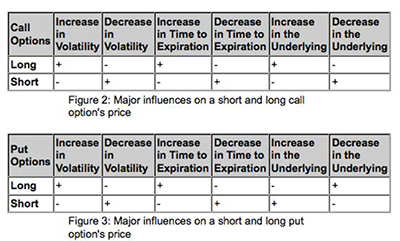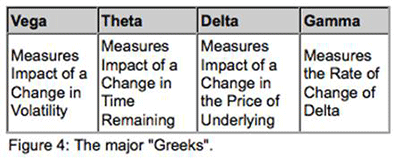Careful analysis of the “Greeks”—the four major measures of option risk—is crucial for every trade. Here is an overview and key points on each.
An option's price can be influenced by a number of factors. These factors can either help or hurt traders, depending on the type of options positions they have established.
To become a successful option trader, it is essential to understand what factors influence the price of an option, which requires learning about the so-called "Greeks"—a set of risk measures that indicate how exposed an option is to time decay, implied volatility, and changes in the underlying price of an equity, commodity, etc.
In this article, we'll look at four Greek risk measures—Delta, Theta, Vega, and Gamma—and explain their importance. But first, let's review some related option characteristics that will help you better understand the Greeks.
What Influences an Option's Price?
The graphic below lists the major influences on both a call and put option's price. The plus or minus sign indicates an option's price direction resulting from a change in one of the price variables in Figure 1.
For example, taking call options and looking at the impact of a change in implied volatility shows that when there is a rise in implied volatility, there is an increase in the price of an option (all other things remaining the same).
Bear in mind that results will differ depending on whether you go long or short an option. Naturally, if you go long a call option, a rise in implied volatility will be favorable because rising implied volatility typically gets priced into the option premium. If you establish a short call option position, on the other hand, a rise in implied volatility will have an inverse (or negative sign) effect. The writer of a naked option, be it a put or a call, would therefore not benefit from a rise in volatility because writers want the price of the option to decline.
Figures 2 and 3 below present the same variables, but in terms of long and short call options (Figure 2) and long and short put options (Figure 3). Note that a decrease in implied volatility, a reduced time to expiration, and a fall in the price of the underlying will benefit the short call holder. At the same time, an increase in volatility, a greater time remaining on the option, and a rise in the underlying will benefit the long call holder. Figure 3 shows that a short put holder benefits from a decrease in implied volatility, a reduced time remaining until expiration, and a rise in the price of the underlying. Meanwhile, an increase in implied volatility, a greater time remaining until expiration, and a decrease in the price of the underlying will benefit the long put holder.
Because interest rates play a negligible role in a position during the life of most option trades, we will be excluding this price variable from the discussion. It is worth noting, however, that higher interest rates make call options more expensive and put options less expensive (all other things remaining the same).
This summary of the influences on option price provides a nice backdrop for an examination of the risk measures used to gauge the degree to which an option's price is influenced by these price variables. Let's now take a look at how the Greeks permit us to project changes in an option's price.
Article Continues on Page 2
|pagebreak|The Greeks
Figure 4 below contains four major risk measures (our so-called Greeks), all of which a trader should take into account before taking any option position. Because the Greeks are actually represented by letters of the Greek language alphabet, let's take them in alphabetical order.1. Delta
Delta is a measure of the change in an option's price (premium of an option) resulting from a change in the underlying security (i.e. stock) or commodity (i.e. futures contract). The value of delta ranges from -100 to 0 for puts and 0 to 100 for calls (here delta has been multiplied by 100 to shift the decimal). Puts have a negative delta because they have what is called a "negative relationship" to the underlying, i.e. put premiums fall when the underlying rises, and vice versa.
Call options, on the other hand, have a positive relationship to the price of the underlying, i.e. if the underlying rises, so does the premium on the call, provided there are no changes in other variables like implied volatility and time remaining until expiration. And if the price of the underlying falls, the premium on a call option (provided all other things remain constant) will decline. An at-the-money option has a delta value of approximately 50 (0.5 without the decimal shift), which means the premium will rise or fall by half a point with a one-point move up or down in the underlying. For example, if an at-the-money wheat call option has a delta of 0.5, and if wheat makes a ten-cent move higher (which is a large move), the premium on the option will increase by approximately five cents (0.5 x 10 = 5), or $250 per contract (each cent in premium is worth $50).
As the option gets further in the money, delta approaches 100 on a call and -100 on a put, which means that at these extremes, there is a one-for-one relationship between changes in the option price and changes in the price of the underlying. In effect, at delta values of -100 and 100, the option behaves like the underlying in terms of price changes. This occurs with little or no time value, as most of the value of the option is intrinsic. We'll come back to the concept of time value below when we discuss Theta.
Three things to keep in mind with Delta:
- Delta tends to increase as you get closer to expiration for near- or at-the-money options
- Delta is not a constant, a fact related to Gamma, our next risk measurement, which is a measure of the rate of change of Delta given a move by the underlying
- Delta is subject to change given changes in implied volatility
2. Gamma
Gamma, also known as the "first derivative of Delta," measures Delta's rate of change. Figure 5 shows how much Delta changes following a one-point change in the price of the underlying. This is a simple concept to grasp. When call options are deep out of the money, they generally have small Delta values. This is because changes in the underlying bring about only tiny changes in the price of the option. As the call option gets closer to the money, resulting from a continued rise in the price of the underlying, the Delta gets larger.
In the above graphic, Delta is rising as we read the figures from left to right, and it is shown with values for Gamma at different levels of the underlying. The column showing profit/loss (P/L) of -200 represents the at-the-money strike of 930, and each column represents a one-point change in the underlying. As you can see, at-the-money Gamma is -0.79, which means that for every one-point move of the underlying, Delta will increase by exactly 0.79 (for both Delta and Gamma, the decimal has been shifted two digits by multiplying by 100). If you move right to the next column, which represents a one-point move higher to 931 from 930, you can see that Delta is -53.13 (an increase of .79 from -52.34). As you can see, Delta rises as this short call option moves in the money, and the negative sign means that the position is losing because it is a short position (in other words, the position Delta is negative). Therefore, with a negative Delta of -51.34, the position will lose 0.51 (rounded) points in premium with the next one-point rise in the underlying.
These are some additional points to keep in mind about Gamma:
- Gamma is smallest for deep out-of-the-money and deep in-the money options
- Gamma is highest when the option gets near the money
- Gamma is positive for long options and negative for short options (as seen above in Figure 5 with our example of a short call)
NEXT: Option Greeks Theta and Vega
|pagebreak|3. Theta
Theta is not used much by traders, but it is an important conceptual dimension. Theta measures the rate of decline in time-premium resulting from the passage of time. In other words, an option premium that is not intrinsic value will decline at an increasing rate as expiration nears. Figure 6 shows Theta values at different time intervals for an S&P 500 Dec at-the-money call option. The strike price is 930. As you can see, Theta increases as expiration gets closer (T+25 is expiration). At T+19, which is six days before expiration, Theta has reached 93.3, which in this case tells us that the option is now losing $93.30 per day, up from $45.40 per day at T+0, when we hypothetically opened the position.
Some additional points about Theta to consider when trading:
- Theta can be very high for out-of-the-money options if they contain a lot of implied volatility
- Theta is typically highest for at-the-money options
- Theta will increase sharply in the last few weeks of trading and can severely undermine a long option holder's position, especially if implied volatility is on the decline at the same time.
4. Vega
Vega, our fourth and final risk measure, quantifies risk exposure to implied volatility changes. Vega tells us approximately how much an option price will increase or decrease given an increase or decrease in the level of implied volatility. Option sellers benefit from a fall in implied volatility, and it's just the reverse for option buyers. Referring to Figure 5 above, you can see that the short call has a negative Vega, which tells us that the position will gain if implied volatility falls (hence the inverse relationship indicated by the negative sign). The value of Vega itself indicates by how much the position will gain in this case. Using at-the-money Vega, which is -96.94, we know that for each percentage-point drop in implied volatility, a short call position will gain by $96.94.
Conversely, if there should be a 1% rise in implied volatility, the position would lose $96.94.
Additional points to keep in mind regarding Vega include the following:
- Vega can increase or decrease even without price changes of the underlying because implied volatility is the level of expected volatility
- Vega can increase from quick moves of the underlying, especially if there is a big drop in the stock market, or if there is a sudden upward burst in a commodity (i.e. coffee spikes after a reported frost in Brazil)
- Vega falls as the option gets closer to expiration
While this overview is only an intermediate-level discussion of Delta, Gamma, Theta, and Vega (an advanced level analysis would involve mathematical nuances which are not practical in terms of trading), it should nonetheless help clarify not only how the price of an option is influenced by changes in the underlying, the time to expiration, and the implied volatility, but also how we measure the impact of these variables on an option's price.
Finally, always remember that there is a risk of loss when trading futures and options. Trade only with risk capital.
By John Summa, CTA, PhD, founder of OptionsNerd.com and HedgeMyOptions.com
See Video: Option Traders Need the Greeks

























